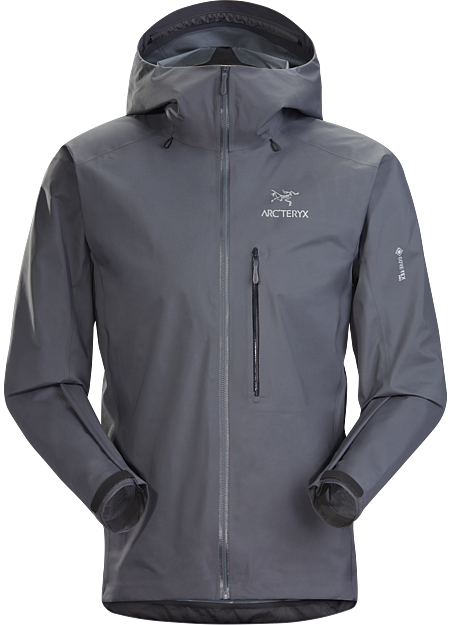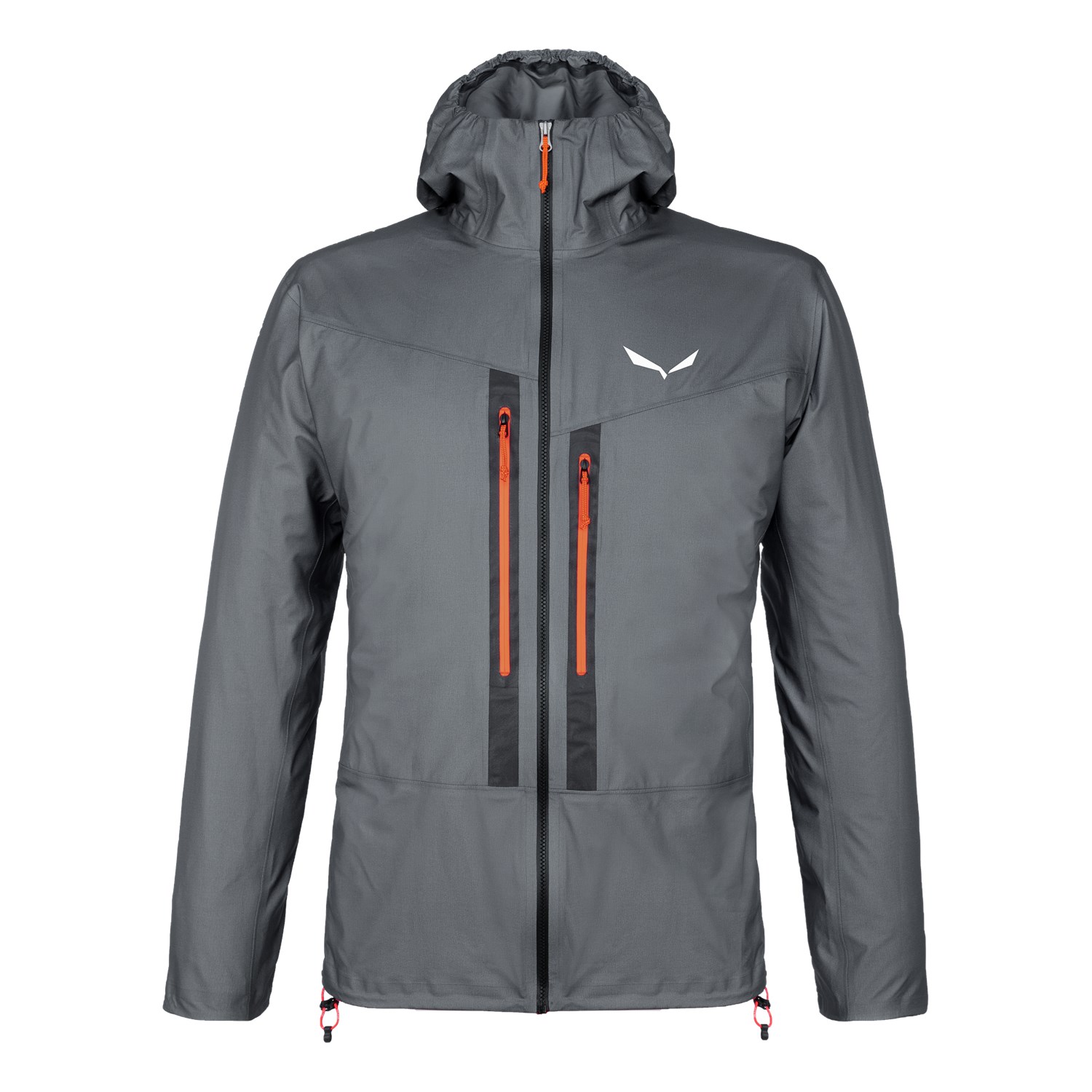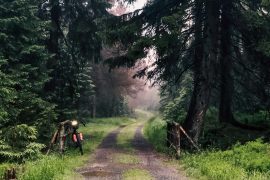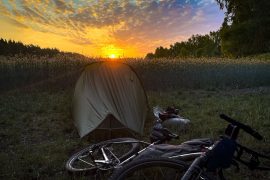Notes:
I mention many brands and models below. However, I am not supported or sponsored by any of these brands. Therefore, this is not really advertising, but I wanted to say it anyway. And: I have researched and compiled the manufacturers’ specifications for all the jackets. Of course, I have not worn or tested all the jackets myself.
In the last few weeks I have been intensively looking into the topic of jackets, or more precisely weather/rain jackets. The reason is that I am currently thinking about possibly taking part in the Silk Road Mountain Race in 2021 (fingers crossed). This of course includes the right jacket to not only withstand the alpine and very dynamic weather conditions in Kyrgyzstan, but also to be able to stay exposed to them for as long as possible. Besides, I need a new all-weather functional jacket anyway…
My requirements:
Very Important:
- High breathability under heavy load on the bike
- Durably waterproof
- Waterproof zips
- Absolutely windproof
- Robust, abrasion- & tear-resistant, resilient material
- Low weight (up to max 500g)
- Small pack size
- Helmet-compatible hood, ideally with shield
Desirable:
- Underarm ventilation
- Side pockets/Napoleon pocket
- Easy care
- Sustainability in materials (recycling) and production
I know this reads like a partner request on Tinder and I know it will probably be very difficult to meet my requirements. After doing some research, I also think that the manufacturers don’t really make it easy to find the right one.
I was particularly bothered by the fact that as a normal consumer, you are at the mercy of an incomprehensible and fragmented mass of information. Either technical terms and data are thrown around, or they are omitted altogether. Often you can’t even find weight information, back lengths or detailed information on the material used and its effect. And I particularly noticed that hardly any manufacturer can really communicate well whether the advertised performance of a jacket actually takes place in practice.
Practical experience 1: Endura MT500 rain jacket
Before I go into the selection of jackets, a short excursus on the rain jackets I currently own. Also so that you understand why I am now looking for a new jacket “again”.
At the beginning of 2018, I bought the Endura MT500 rain jacket. And I was thrilled with it too: it was waterproof, it was surprisingly breathable and it kept me warm when I was sweaty. And I actually wanted to ride with this jacket, as I did before with my Mountain Equipment Karakorum jacket, for 10 years at least.
According to the manufacturer, the MT500 is specially designed for bad weather with simultaneous physical activity (MTB riding). I really liked the longer back, the hood and the underarm ventilation. The robustness of the hardshell material was also convincing.

But unfortunately, after about a year, the jacket lost its waterproofness. It started getting wet on the shoulders and later on the back. Normally I can ride for a long time in heavy rain without it getting uncomfortable inside the jacket. But now the MT500 simply soaked up and was no longer waterproof and stuck to the skin. Numerous attempts to impregnate it were unfortunately unsuccessful. I assume that the DWR impregnation has weakened and I could not restore it either by thermal treatment or appropriate “washing in” or by external re-waterproofing. Interestingly, I have observed the same effect with the MT500 rain pants, which I use on very cold days but now prefer to be dry, as they are simply no longer waterproof.
At the moment I only use the MT500 rain jacket for hiking or in everyday life as a weather jacket when it doesn’t really matter. For cycling, I only use it for commuting at most. It’s a shame, because at 230 euros it wasn’t exactly cheap.
In the meantime, Endura has reworked the MT500 twice and now uses the material called ExoShell60, which promises a waterproofness of 18,000mm and more and an extremely high breathability of now 64,000 g/m²/24h (I’ll explain the terms later). Unfortunately, I can’t judge whether it’s better.
Practical experience 2: Gore Shakedry C7 jacket
Last autumn I started training for the Atlas Mountain Race and needed a lightweight, breathable and waterproof jacket. It was at this time that I became aware of Gore’s Shakedry materials, which many riders were very enthusiastic about. The Shakedry C7 jacket is a very form-fitting jacket with a very thin fabric reminiscent of parachute silk.

However, Gore has really achieved a small miracle: the jacket is absolutely and permanently waterproof and extremely breathable. The best thing: if it’s wet, all you have to do is shake it and it’s halfway dry. The Shakedry C7 is also windproof. At a weight of just under 100g, it was and is currently my first choice for bad weather. In Morocco it provided me with the necessary warmth and protection from cold winds, and on my tours in Germany it was permanently impervious to rain and snow. And that’s why I can definitely recommend it. However, at 250 to 300 euros, it costs a lot of money.
Nevertheless, in my opinion it has three “disadvantages” that make it not ideal for use in Kyrgyzstan or for Bikepacking (with luggage – no gravel):
It is quite tear-resistant, but the fabric is so thin that there is definitely a risk of damage. I have already got tangled up in thorns and bushes several times with the jacket, and there are marks in the jacket accordingly. After a fall, there are also abrasion marks on the outer fabric. When I carry my bike, I’m worried about damaging the jacket.
No hood: To be honest, I don’t need it at home either. However, in snowstorms and rainstorms I would like to have access to a hood. And it should offer me enough field of vision and also go over a helmet.
Quite tight: I am quite slim, but the Shakedry jacket is cut very tightly for racing. I can wear a midlayer underneath, but when the zip is closed, I feel cramped in the chest area. This takes a bit of getting used to, especially on the mountain, where I breathe more and harder. I find this quite annoying and would like to have a jacket with more space. In addition, it is cut shorter at the front, which is why the lap area is free and not protected when you are not sitting on the bike.
Technical terms: Membrane, technologies and features – an explanation
Now you understand why I’m looking into jackets. And when I do, I also want to share my research with you, in case one of you is also looking for something and needs some advice and inspiration.
When you start to look into the subject, you immediately come across a lot of technical terms and substance names. It’s easy to lose track of them all.
For this reason, I have compiled all the terms and membranes that I have come across and that are important to know in order to understand and classify the information in my jacket list:
DWR:
Durable Water Repellency = permanently waterproof. This type of impregnation ensures that the water that hits the material rolls off and does not form “puddles”. You can compare the DWR with the Lotus effect, but the DWR eventually wears off through use and washing and has to be renewed. However, DWR impregnations are not really or completely environmentally friendly because PFC/fluorocarbons or surfactants are used.
Water pillar:
This is not only an important topic for clothing, but it still needs some clarification. The water pillar is given in mm and basically tells you how much water can press on a certain surface of the fabric before it becomes permeable. The higher the water pillar value, the denser the fabric. According to international standards, jackets with a water pillar of 800mm or more are considered waterproof. During my research I read that in Switzerland, for example, this is only the case from 4,000mm.
In Germany, waterproofness is regulated according to the EU standard EN 343:2003, which defines waterproofness as a water pillar of 1,300mm for clothing that is exposed to high stress. For clothing that is exposed to less stress, a water resistance of 800mm is sufficient to be called waterproof.
You will notice that we perhaps take the topic of water pillar a little too seriously, but most functional jackets already have more than 10,000 and often around 20,000 and more mm water pillar. So they are well equipped for bad weather.

Breathability:
This means the water vapour permeability, i.e. perspiration. The higher the water pillar/waterproofness of a fabric, the less breathable it is. However, I have found jackets whose fabric combinations or new membranes have managed to combine both more than optimally.
Breathability is either given in g per m2 per 24h aka Moisture Vapour Transmission Rate (MVTR value) or as RET value. This is then confusing for us non-experts as we can’t really compare or understand both values.
The MVTR value indicates how much water vapour (in g) per cubic metre (m2) is transported through the fabric in 24h. However, this value is considered inaccurate because factors such as temperatures or air permeability of the respective materials are probably not practically taken into account here.
The RET value is no better. It determines the water vapour transmission resistance. This is a remarkable word, but it does not make the understanding any better. At least the determination of the RET value takes place under ISO and EU standards. For the non-expert, the greater the RET value, the lower the breathability. RET values of 6 and lower are therefore extremely breathable, values of 6-13 very breathable.
In the list below, however, you will find both MVTR and RET values, as the manufacturers state them differently.
Waterproof and water-repellent:
In principle self-explanatory, but when it comes to zips at the latest, it is interesting to know what exactly is meant by water-repellent. Waterproof is waterproof. That’s it. No water gets in, no matter how long it rains or is exposed to water. In principle, water-repellent is waterproof for a limited period of time. In the case of clothing, it means that when it rains, the fabric soaks up but does not penetrate. But at some point it will. And that takes time, depending on how good the impregnation is. In the case of zips, this means that they basically prevent water from penetrating, and are sometimes supported by cover strips on the inside or outside, but in the case of constant rain, water can penetrate at some point.
Interestingly, the majority of the jackets on my list have only one water-repellent zip. Often the YKK Aquaguard is used here. These are extra coated and specially designed to keep the water out. The YKK Aquaseal are then actually waterproof.

During my research, the Gore-Tex membranes (Active, Shakedry, Paclite and Pro) and the Dermizax membrane stood out. They all seem to be getting closer and closer to the holy grail: Being absolutely waterproof, while at the same time being extremely breathable and windproof.
Dermizax:
This membrane comes from the Japanese Toray company and is highly praised for its waterproofness with very high breathability. The difference to Gore Tex and co. is that no membrane with pores is used here, but a so-called hydrofiles material that contains molecules that bind water specifically and transport it to the outside. The higher the temperature, the faster the movement of the molecules.
Of course, this always depends on the outside temperature and humidity. I follow the old “Gore formula”: functional materials usually only work below 15 degrees Celsius. You can forget about anything above that.
Dermizax is based on polyurethane. This substance is found in many products and is mostly used for insulation. In clothing, polyurethane is used as microfoam. And it has the advantage of being 100% recyclable.
Apparently, Derzimax clothing can be washed indefinitely without losing its functionality. And it is quite impressive: the Derzimax membrane has a waterproof rating of over 20,000mm and a breathability rating of an impressive 30-50,000 g/m2/24h.
Sympatex:
Along with Gore, Sympatex is one of the better known functional membranes. However, apart from Triple2, I couldn’t find this membrane in any of the other jackets. Sympatex is considered particularly environmentally friendly because this membrane is polytetrafluoroethylene aka PTFE free and is fully recyclable.
Sympatex has no pores and, to put it simply, works through the simple temperature/humidity difference between the inside and the outside. The greater this difference, the better the Sympatex membrane is said to work. The hydrophilic part of the membrane binds and transports moisture to the outside, where it evaporates. At the same time, the membrane is 100% waterproof, because its structure does not allow water droplets to penetrate. However, this also depends on the DWR impregnation.
Gore-Tex:
There are various membranes here that were of interest to me in connection with my research.
Gore-Tex Active:
Nomen est Omen – Active is the material for active sports, such as cycling or trail running. It is probably very light, extremely breathable, waterproof & windproof and also has a quite small pack size. Active is also called a laminate, which means that the base material (shell) is firmly welded to the membrane.
Gore-Tex Active achieves an impressive RET value of <3, which is interesting because it allows you to combine a durable hardshell jacket with the Active membrane. However, the Active models are weight-oriented, which is why extremely robust materials like Gore-Tex Pro are not used here. This means that Active jackets are optimised for weight and performance, but not for extreme robustness and resilience. Therefore, Active jackets are not necessarily suitable for heavy backpacks.
Gore-Tex Pro:
As already written, the Pro membrane is something for tough applications. Probably not for my needs, as robustness is often at the expense of weight and breathability. However, Gore has redone everything here and now offers the Pro membrane in three different functional directions: Most Rugged, as very resistant, Most Breathable, very breathable, and Stretch, meaning more freedom of movement. When and how which of the Pro materials are used is often not clear, or they are probably also combined.

Gore-Tex Paclite:
There are some jackets that use Paclite that I would classify as interesting. Paclite is – as the name suggests – very light and easily compressible. My new rain pants, for example, are made of Gore-Tex Paclite. As a 2-layer laminate, Paclite is welded to the base material, but does without an inner lining. This makes it feel more technical and less natural. According to Gore, however, carbon is applied to the inside of Paclite so that any dirt comes off better.
Compared to the Active membrane, Paclite is somewhat more durable, whereas Active offers better breathability for strenuous sports. In essence, an active cyclist never bets on the wrong horse with a jacket made of Paclite or Active.
Gore-Tex Shakedry:
As the name suggests, all you need to do is shake out the jacket and it’s dry again. I’m very impressed with this material so far, because it’s extreme: light, breathable, waterproof and windproof. However, it’s not really suitable for backpacking and the often very body-hugging cut makes it somewhat restrictive, even though Gore incorporates its stretch technology here. It should be said, however, that Shakedry probably does not work without PFC, which means deductions in the environmental rating.
Basically, Gore-Tex membranes need to be looked at more closely from an ecological point of view.
Layers:
There are 3, 2.5 or 2-layer jackets. 3-layer jackets consist of the respective membrane, which is bonded on the outside and inside with the corresponding carrier material. 2-layer jackets consist only of the outer layer and membrane. 2.5-layer jackets get half the layer from a light protective layer on the inside against dirt.
39 Jackets for Bikepacking & Bicycle Touring
So now let’s talk about jackets. At the beginning I thought I would find maybe 10-12 jackets that offer roughly what I would like. In the end it turned out to be almost 40, also because I expanded the search and collected jackets for you that might be interesting for gravel and bicycle touring beyond Bikepacking.
So that you can make up your own mind, you can download the overview as a PDF HERE or the table on Google Docs HERE.
My TOP 5
I will take a closer look at 5 jackets from this selection:
- the Arc’teryx Alpha FL
- the Mountain Equipment Garwhal
- the 7mesh Revelation
- the Montane Pac Plus
- the Salewa Lagorai
Arc´teryx Alpha FL
It thus seems to be an almost perfect match to my requirements. Only the underarm ventilation is missing, but this should probably be compensated by the basically high breathability. Unfortunately, the jacket is only available in two colours that are not really acceptable to me…
The downside is the very high price of 450 euros.
Mountain Equipment Garwhal
The Mountain Equipment Garwhal made it into my selection because of my old connection with this brand, but also because of its performance. My first functional jacket was the Mountain Equipment Karakorum, which I bought in 1997 for my tour in the Himalayas. After this jacket wore out after many years, I got the successor model and only replaced it in 2018 with the Endura MT500 reviewed above.
The Garwhal is made of Gore Paclite and designed for alpine climbing and high altitude touring. Despite the Paclite, it’s not lightweight at 345g, which suggests it’s more robust. It compresses well. What makes me a bit “nervous” is the “sporty cut” fit. This could well mean that it is quite tight, which would then give me a shakedry feeling again. I’ll have a look at this jacket in the shops and try it on. It is reasonably priced at around 220 euros.
7mesh Revelation
7mesh is a Canadian company that (quite rightly) had the impression that clothing for hikers and mountaineers was always being developed further, but that clothing for cyclists was lagging behind. So the 7mesh people set out to change that and have developed some very interesting products.
The Revelation jacket is made of Gore-Tex Pro, but weighs only 300g. It is made as a jacket for all eventualities and is intended to do justice to domestic rounds as well as extended ultra-bikepacking trips. And with it, all the corresponding weather conditions. That sounds interesting and so the Revelation made it into my selection. Waterproof zips and a cut adapted to cycling round off the offer. However, the price of 475 euros is quite high.
Fun fact: the makers of 7mesh were all involved in the construction of Arc’teryx.
Montane Pac Plus
Salewa Lagorai
With the Lagorai (named after the mountain range in the Alps), Salewa has a Gore-Tex Active jacket on offer that is still very new. At the moment it is not available, but hopefully that will change. With only 215g it is a real lightweight and thanks to Gore Active it has a very good RET value of >3.5, which promises extremely high breathability. It is waterproof and windproof anyway.
Salewa developed it for use on fast, sporty mountain tours and sees it there as a kind of emergency shell. Its zip is waterproof and there are corresponding zips in the chest area for additional ventilation. The price is quite high at 320 euros, but I honestly find this jacket very promising for my needs.
Folks, please don’t ask me to make a decision now. I really hope that one or the other of you owns one of these jackets and actively uses it and can tell me what it’s like. At the moment, my heart beats for the 7mesh, the Mountain Equipment and the Arc’teryx.
But first Tobias and I have to be accepted for the Silk Road…
My 6 alternatives
But of course there were other jackets from my research selection that I also find interesting and suitable:
- the Endura MT500 model 2020
- the Decathlon Simond Alpinism light
- the Gore C5 Trail hooded jacket
- the 7mesh Copilot
- the Patagonia Torrentshell 3L
- the Triple2 Smudd nul
Endura MT500 – Modell 2020
I like the approach and the jacket, but unfortunately my MT500 wasn’t waterproof. Now Endura presented a new version a few weeks ago, which is supposed to be much more breathable, waterproof and windproof than my old jacket.
I think Endura, as well as 7mesh, are basically good companies, because they come from the cycling world and know what is needed here. And in essence, according to Endura’s specifications, the MT500 is the perfect jacket for my needs. But I’m still unsure. So if any of you have now picked up the MT500, please let me know and report back.
What takes it out of the running is the high weight of 500g compared to the other jackets.
Decathlon Simond Alpinism light
It weighs 400g, has a reasonable waterproof rating of 15,000mm and a RET rating of 8. That’s not great, but it’s not bad either. Especially when you consider the price of 130 euros. Honestly, this is an alternative if you don’t want to spend millions on presumed high technology from other brands. I’ll take a look at them.
Gore C5 Trail Kapuzenjacke
Gore makes pretty good jackets for cycling, hiking and trail running. And I find the combination of Active and Paclite in the Gore C5 Trail in combination with a hood interesting, especially when the result weighs only 240g. I’m hoping for good resistance combined with high suitability for sweaty activities.
It can also be worn with a backpack, which I do on tours like the Silk Road. And this jacket would be a good compromise between weight and performance compared to the Shakedry C7. However, the price of 270 euros is quite high again.
7mesh Copilot
I’m really impressed by the Canadians and I also find their Gore Paclite-based Copilot jacket very interesting. 2 layers, 235g and “only” 250 euros – that’s a good offer, especially since 7mesh has the cyclist/bikepacker in mind when it comes to design and production. And the zip is waterproof.
Maybe this jacket is something for my top selection after all?
Patagonia Torrentshell 3L
The Patagonia Torrentshell is somehow the most logical choice among all the jackets. It is ecologically produced, seems to be reasonably waterproof and breathable, has underarm ventilation, weighs 394g, not much, but not little either, and at 160 euros it doesn’t cost the world.
I find it interesting, but at the same time I don’t quite trust it for use in my active conditions. Maybe I’m just underestimating it.
Triple2 Smudd nul
But is it a jacket for alpine areas and rides? I can’t really judge, especially since apart from performance data there is no further information or classification on the Triple2 site.
The price of 280 euros is high, but fair.
Conclusion/Summary
Let’s be honest: a rain jacket that is absolutely waterproof and breathable doesn’t exist yet. But I am confident that the new membrane technologies have brought us a little closer to this grail.
I have learnt a lot about jackets, membranes and possibilities by researching and writing about them. And of course I hope that you can also benefit from this, should you be considering the topic of weather jackets for cycling.
In the end, it’s always a question of price: do you want to invest a lot of money in a jacket that might not deliver what it promises? Or is it better to buy cheaper in this case, also because the expensive products are not much better in the end? I’m pretty sure that this will always remain an unsolved mystery .
In any case, I am quite satisfied with my selection and will use the next time to look at the jackets in real life and try them on.
Of course, my selection does not include all jackets that might fit into the frame I have defined. So please feel free to write if you know of other jackets that you like.
And of course please also let me know if you have one of the jackets mentioned here and can report on it from practical experience.
Overview of 39 jackets for Bikepacking & Bicycle Touring
Here you will find all jackets with selected information (scroll horizontally if necessary). If you want to have a look at the complete list with all details, you can do so here on Google Docs.
| Brand | Model | Material/Membran | Weight | Price in Euro | Link |
| 7mesh | Revelation Jacket | GORE-TEX® 3L Pro – 40d Nylon Plain Weave | 299g | 475 | https://7mesh.com/mens-revelation-jacket |
| 7mesh | Copilot Jacket | GORE-TEX Paclite® Plus 2L, 40d Recycled 100% nylon | 235g | 250 | https://7mesh.com/copilot-jacket |
| Alpkit | Gravitas | 7d Nylon | 170g | 185 | https://alpkit.com/products/gravitas-mens |
| Alpkit | Definition | 40D x 90D Nylon | 515g | 260 | https://alpkit.com/collections/mens-waterproof-jackets/products/definition-mens |
| Alpkit | Balance | 90% Nylon/10% Spandex / PFC-free Dauerhaft Wasserabweisend | 410g | 205 | https://alpkit.com/collections/mens-waterproof-jackets/products/balance-mens |
| Arc’teryx | Alpha FL Jacke | GORE-TEX PRO, 100% Polytetrafluorethylen | 340g | 450 | https://arcteryx.com/de/de/shop/mens/alpha-fl-jacket |
| Assos | Trail Steinbeisser | Assos-eigenes dreilagiges wasserfestes Softshell-Material mit DWR | 230g | 380 | https://www.assos.com/TRAIL-Steinbeisser-Rain-Jacket?quantity=1&g=TRAIL-Steinbeisser-Rain-Jacket_blackSeries-1-M.jpg&color=113 |
| Bergans | Letto Jacke | Dermizax® von Toray | 460g | 250 | https://www.bergans.com/de/herren/jacken/shelljacken/letto-jacket-navy-solid-grey |
| Decathlon | Simond Bergsteigerjacke ALPINISM LIGHT | Hauptgewebe 100% Polyester (PES) Beschichtung 100% Polyurethan (PUR) | 400g | 130 | https://www.decathlon.de/p/bergsteigerjacke-wasserdichte-alpinism-light-herren/_/R-p-161091 |
| Dynafit | TLT GTX Jacke | Hybride Gore-Tex Active Konstruktion mit Gore-Tex Paclite Plus, ePTFE-Membran | 310g | 300 | https://www.dynafit.com/de-de/tlt-gore-tex-jacke-herren-08-0000071366 |
| Endura | MT 500 | Endura ExoShell60™ drei-Lagen-Gewebe | 508g | 230 | https://www.endurasport.com/MT500-Wasserdichte-Jacke/p/E9117-Azure-Blue |
| Enlightened Equipment | Men’s Visp Rain Jacket Custom | ultralight 7D ripstop nylon, a waterproof/breathable ePTFE membrane | 168g | 200 | https://enlightenedequipment.com/mens-visp-rain-jacket-custom/ |
| Gore Tex | R7 Gore-Tex Shakedry Trail Hooded Jacket | GORE-TEX SHAKEDRY™, 100% Polytetrafluorethylen | 175g | 300 | https://www.gorewear.com/de/de-de/r7-gore-tex-shakedry-trail-kapuzenjacke-100457.html?countryselector=de_DE |
| Gore Tex | C5 GORE-TEX Trail Kapuzenjacke | GORE-TEX Active + GORE-TEX PACLITE® | 240g | 270 | https://www.gorewear.com/de/de-de/c5-gore-tex-trail-kapuzenjacke-100528.html |
| Gore Tex | C3 GORE-TEX Paclite® Kapuzenjacke | GORE-TEX PACLITE® Plus | 282g | 200 | https://www.gorewear.com/de/de-de/c3-gore-tex-paclite-kapuzenjacke-100036.html |
| Haglöfs | L.I.M Jacket – Regenjacke | Gore-Tex Paclite Plus | 230g | 250 | https://www.haglofs.com/de/de-de/l.i.m-jacket-men/p/604542-2C5.html? |
| Millet | Trilogy V Icon Dual GTX Pro | Gore Tex und Gore Tex Pro Astree 3-Lagen Material | 465g | 600 | https://www.millet-mountain.de/trilogy-vidg-pj-saphir-saphir.html |
| Mont-Bell | Versalite Jacket | 10-denier GORE® WINDSTOPPER® | 182g | 215 | https://www.sackundpack.de/product_info.php?products_id=6974 |
| Montane | Minimus Jacket | Pertex Shield, 100% Polyamidd, PU beschichtet | 190g | 180 | https://www.montane.eu/herren-c1/minimus-jacket-p767 |
| Montane | Meteor Waterproof Jacket | 40 Denier Pertex Shield | 340g | 140 | https://www.montane.eu/herren-c1/montane-mens-meteor-waterproof-jacket-p931#attribute%5B3%5D=13 |
| Montane | Alpine Spirit Waterproof Jacket | 70 Denier GORE-TEX Performance | 480g | 330 | https://www.montane.eu/herren-c1/montane-mens-alpine-spirit-waterproof-jacket-p929#attribute%5B3%5D=13 |
| Montane | Pac Plus Jacket | 30 DEN GORE-TEX PACLITE® PLUS | 283g | 220 | https://www.montane.eu/herren-c1/pac-plus-jacket-p836#attribute%5B3%5D=13 |
| Mountain Equipment | Skardu Jacket | GORE-TEX PACLITE® PLUS | 240g | 290 | https://www.mountain-equipment.de/collections/herren-jacken/products/skardu-jacket |
| Mountain Equipment | Saltoro Jacket | GORE-TEX 75D + GORE-TEX PACLITE® mit wasserabweisender PFC EC freier DWR Ausrüstung | 430g | 300 | https://www.mountain-equipment.de/collections/herren-jacken/products/saltoro-jacket |
| Mountain Equipment | Garwhal Jacke | GORE-TEX PACLITE®, ePTFE-Membran, DWR Imprägnierung | 345g | 220 | https://www.mountain-equipment.de/products/garwhal-jacket?_pos=1&_sid=a944a4602&_ss=r |
| Norrona | Men’s Fjørå Dri1 Jacket | dri™1 , 100% Polyamide | 200g | 250 | https://www.norrona.com/de-DE/produkte/fjora/fjora-dri1-jacke-herren/?color=3897 |
| Norrona | Lyngen GTX Jacke | Gore-Tex Active | 320g | 500 | https://www.norrona.com/de-DE/produkte/lyngen/lyngen-gore-tex-jacke-herren/?color=5331 |
| Outdoor Research | Helium II Jacket | Pertex Shield | 180g | 120 | https://www.outdoorresearch.com/us/mens-helium-ii-jacket-242969 |
| Patagonia | Torrentshell 3L Jacket | H2No™ Performance (Econyl, eine recycelte Polyesterfaser) | 394g | 160 | https://eu.patagonia.com/de/de/product/mens-torrentshell-3l-rain-jacket/85240.html?dwvar_85240_color=BLK |
| RAB | Downpour Plus Jacket | Pertex Shield, 100% Polyamidd, PU beschichtet | 340g | 160 | https://www.bergfreunde.de/rab-downpour-plus-jacket-regenjacke/ |
| Salewa | Lagorai | Gore-Tex Active | 215g | 320 | https://www.salewa.com/de-de/lagorai-gore-tex-active-herren-jacke-00-0000027900?number=00-0000027900_0000000001&c=316585 |
| Schöffel | 3L Jacket Aletsch M | Dermizax®NX Ripstop | 380g | 330 | https://www.schoeffel.com/de/de/schoeffel-3l-jacket-aletsch-m-rot-5466-738 |
| Shower Pass | MEN’S IMBA JACKET | Getaped Artex Hardshell, 100% Polyamid | 435g | 200 | https://showerspass.co.uk/products/mens-imba-jacket?variant=49795819663 |
| Shower Pass | Elements | “fully seam taped, waterproof-breathable hardshell “ | 473g | 180 | https://www.showerspass.com/products/mens-element-jacket |
| Triple2 | SMUDD nul | Shell: 100% Polyamide, Sympatex mit Bionic Finish Eco Imprägnierung | 190g | 280 | https://triple2.de/herren/highlights/neuheiten/14/smudd-nul-men?number= |
| Vaude | Men’s Moab Rain Jacket | Ceplex Active Membran | 335g | 160 | https://www.vaude.com/de-DE/Herren/Bekleidung/Jacken/Men-s-Moab-Rain-Jacket?number=408489715200 |
| Vaude | Men’s Yaras Jacket II | Ceplex Active Membran | 390g | 160 | https://www.vaude.com/de-DE/Herren/Bekleidung/Jacken/Men-s-Yaras-Jacket-II?number=403346785200 |
| Vaude | ESCAPE BIKE LIGHT JACKET | Ceplex Active Membran | 505g | 100 | https://www.rosebikes.de/vaude-escape-bike-light-jacket-regenjacke-686525 |
| Zpacks | Men’s Vertice Rain Jacket | sqyd Vertice Waterproof Breathable Fabric | 176g | 260 | https://zpacks.com/products/vertice-rain-jacket?variant=9136091693092 |















None of these test seem to mention Paramo jackets. Yes they are not bike specific but I have used them working outdoors (Five years as an outdoor instructor and nearly a year as a cycle instructor) and they have never let me down. I have three different types, a winter smock, a heavy duty ‘country style’ jacket and a lightweight jacket for active wear. Most mountain rescue teams in the UK use them and they work in a rather unconventional way by driving moisture away from the body – both vapour and liquid water (Unlike Goretex etc which only works with vapour). They are expensive but my original jacket is 18 year old and, although looking decidedly shabby, still keeps me very dry. I don’t know why more cycle tourists don’t use them – maybe they are not on the radar?